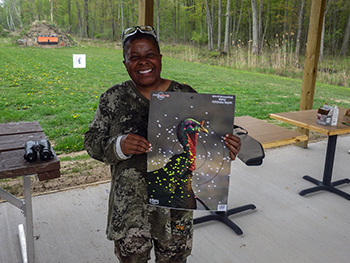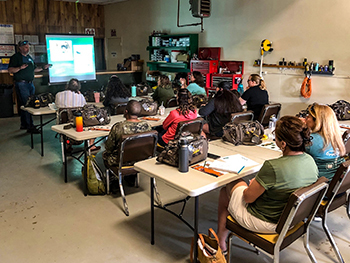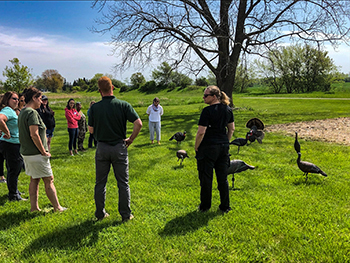Becoming an Outdoors-Woman program would make Annie Oakley smile
Editor’s note: This week’s Showcasing the DNR feature story is written by freelance outdoors writer Tom Lounsbury. This is a special feature to our series.
By TOM LOUNSBURY
Freelance outdoors writer
Phoebe Ann Moses was known as the famed shooter “Annie Oakley” in the late 1800s and would be very pleased with the outdoor opportunities available to girls and women today.
Annie was 6 years old when her father died, causing her family, living in a log cabin in western Ohio, to become impoverished.
To help support her mother and siblings, Annie began trapping at age 7 and shooting at age 8 and possessed a natural skill with any firearm for always hitting her mark. Besides shooting for the family table, she also sold game to local shopkeepers and restaurants, and gained fame for her prowess.

At age 15 and only 5 feet tall, she would outshoot traveling show marksman Frank Butler and would be able to pay off the family mortgage with the winnings. She and Butler would marry a year later and form their own traveling show, and they later joined Buffalo Bill’s Wild West Show, where she became well known as Annie Oakley.
One of the show’s stars, Sitting Bull, was so impressed with Annie’s shooting skills that he called her “Little Sure Shot."
During the early 20th century, Annie Oakley began strongly supporting women’s rights and even taught shooting classes for women to be able to defend themselves. She remained an unbeatable shooting competitor until the end of her years.
In 1991, the University of Wisconsin did a study that determined women preferred to learn in a noncompetitive atmosphere with other like-minded women, and Becoming an Outdoors-Woman got its start. Today, BOW is offered in 38 states and six Canadian provinces.
Michigan began its first BOW program in 1997, and the workshops always quickly fill to capacity. Women are the fastest-growing demographic in the outdoors, and there are outdoors-related garments and equipment available solely targeting girls and women.
In 2017, Ron Sting of the Michigan Department of Natural Resources Cass City field office developed a BOW turkey hunting workshop, which has since taken place (except during the pandemic in 2020 and 2021) each spring in the Lower Peninsula’s Thumb area.
The Thumb, with 60,000 acres of public land, offers one of the highest hunter success rates in Michigan for spring gobblers and is certainly a great area to introduce women to a unique outdoor pastime.
When asked at the start if I would be a BOW turkey hunting mentor, I didn’t hesitate a bit, and I look forward to it every spring. After all, a key mentor for me in trapping, hunting and fishing was my mother, who had learned to do such from her older brothers to help feed the family during the Depression.
The turkey hunting workshop (available also to girls 10 and older) is available on a first-come, first-served basis online and fills up in a matter of hours. The number of attendees is always dependent upon the number of available hunting mentors, of which Sting strives to obtain as many as possible each spring. This year, I was among a dozen hunting mentors who were available for a dozen women eager to participate during the workshop May 12-13.
|

The first day of the workshop entails classroom work all about turkey hunting, including biology and firearms safety. This is soon followed by a trip to a shooting range at the Cass City Gun Club, where the women get acclimated to their shotguns with the assistance of their assigned mentors.
Michigan Conservation Officer Mike Eovaldi did an excellent job of being the “rangemaster” in ensuring proper safety during the shooting exercise after thoroughly discussing hunter safety during the class.
I have always enjoyed observing the classroom work put on by DNR wildlife professionals, who create a relaxed and very informative atmosphere with a good dose of humor. What I have always observed are women and girls who are there to seriously listen and learn, unlike men who often have preconceived ideas and attitudes. What I have witnessed firsthand are women who are attentive and willing to interact and who ask great questions. They also form a bond with one another early on, which remains during the entire workshop. When it comes to shooting, I’ve seen women who have never touched a gun start comfortably blazing away at the targets and effectively hitting their mark while having a great time!
The second day of the workshop is when the actual hunt takes place, and I always enjoy going to the Cass City DNR field office shortly after 4 a.m., where all the women meet up with their assigned mentors and get ready to head out with excited anticipation.
I look upon the event as a genuine “turkey camp” entailing warm camaraderie, with everyone dressed in camouflage and enjoying coffee and donuts. Pretty soon, we were headed out in all directions to set locations, some on public land and some on private land. My destination was to private land where I had previously set up a tent blind on good ground with a notable number of turkeys in the vicinity.
I was mentoring Kathleen Housler of Royal Oak, who was new to hunting and eager to participate. She had brought her own Winchester 20-gauge pump shotgun and had confidently hit her mark on the shooting range. I was glad I had brought along a Thermacell because mosquitos were ready and waiting. Pretty soon, the sky began to show streaks of a beautiful sunrise, with the accompaniment of birds waking up and singing away. That is when I began calling by using far-reaching hen yelps on my box call.
|

There was an immediate response from gobblers roosting in trees a couple hundred yards behind us. I was soon able to determine we had at least four gobblers headed in our direction. One gobbler especially seemed to be leading the way, and he had a deep gobble I’ve learned tends to come from mature “toms." Because the back of our blind was pressed into a pine tree, I only had the front and side windows open and was anticipating a shot near the decoys placed 20 yards out in front, or through a side window.
I estimated the lead gobbler was quite close behind us and getting ready to commit to our setup, with the other gobblers sounding off not far away, and Kathleen was excited, not to mention ready and waiting with her shotgun. Then, suddenly all went silent, and it became apparent something had caused the gobblers to break off from coming in.
That is when at least 15 deer began running past our blind, and it was clear they were fleeing something. Then a head appeared out of the grass 50 yards away on top of the hill in front of us. It was a coyote gazing intently down at the turkey decoys, no doubt the reason the deer were on the run. The coyote decided there might be an easier meal to be had.
I told Kathleen to be ready to shoot in the event the coyote came in to pounce on the decoys and informed her that coyotes could be shot anytime if they are causing or about to cause problems, something I firmly believe coyotes do 24/7.
However, the coyote sensed something amiss, probably our scent, jumped up fully into view and immediately vacated, leaving Kathleen excited about having seen her first coyote. My conjecture was that two coyotes were involved, with one waiting behind us to possibly intercept what the one out front was pursuing. Coyotes are paired up this time of year and can quite skillfully hunt as a team. Deer, especially fawns, as well as turkeys and whatever else is available, are on the menu. Coyotes aren’t picky!
|

Soon it was time to head back to the DNR field office, and Kathleen, who was great company to almost get a gobbler with, was excited to see what luck her “classmates” had had. It turns out three dandy gobblers had been shot, and everyone got a chance to see how to process a wild turkey for the table, and even try it themselves.
All the women expressed having had a great time, enjoyed meeting new friends and were fully prepared to go turkey hunting on their own. They also went home with a carryall bag full of turkey hunting necessities thanks to the National Wild Turkey Federation, Cabela’s and Ben’s Great Outdoors.
I do believe Annie Oakley’s smiling spirit was present during it all.
For more information on Michigan’s Becoming and Outdoors-Woman program. Visit Michigan.gov/BOW.
Contact the writer of this story at tlounsburyoutdoors@gmail.com.
|
Check out previous Showcasing the DNR stories in our archive at Michigan.gov/DNRStories. To subscribe to upcoming Showcasing articles, sign up for free email delivery at Michigan.gov/DNREmail.
Note to editors: Contact: John Pepin, Showcasing the DNR series editor, 906-226-1352. Accompanying photos and a text-only version of this story are available below for download. Caption information follows. Photos courtesy of Thomas Lounsbury and Ron Sting.
Text-only version of this story.
Classroom: Participants in the Becoming an Outdoors-Woman turkey hunting workshop learn about turkey habits and natural history.
Cleaning: The process of how to dress a wild turkey is being shown to participants in the recent Becoming an Outdoors-Woman turkey hunting workshop.
Group – 1, Group – 2 and Group – 3: Successful hunting participants, instructors and participants are shown outside the Michigan Department of Natural Resources field office in Cass City.
Instruction: Outdoor instruction on turkey decoys was part of the day at a recent Becoming and Outdoors-Woman workshop.
Successful: Two successful wild turkey hunters from the Becoming an Outdoors-Woman workshop are shown walking with their birds.
Target: Monica Dunbar of Mt. Clemens was new to hunting and firearms, but was eager to learn, participate and be involved. Here she is with one of her shooting targets.
|